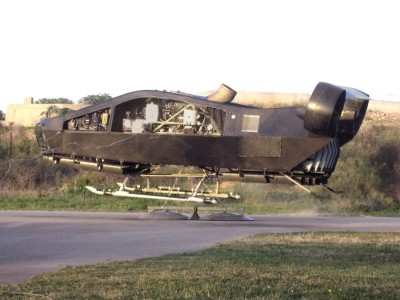Sun, Jan 17, 2010
Urban Aeronautics’ Rotorless VTOL Aircraft Demonstrates
Hover Capability
The AirMule, a single-engine, VTOL Cargo and MedEvac UAS
developed by Israel-based Urban Aeronautics, has successfully
completed the first phase of its flight testing. This phase has
consisted of tethered autonomous hovers with the vehicle’s
Fly-By-Wire control system providing the necessary
auto-stabilization in all three rotational axes of the vehicle ...
pitch, roll and yaw.

Control of the vehicle is accomplished through a company
developed, four channel, redundant flight control system that
relies almost entirely on inertial measurements augmented by GPS
for translational position and velocity readings. Height above
ground is measured by two laser altimeters. 460 channels of
telemetry provide real-time data to the ground based operators,
enabling them to monitor the correct operation of the Turbomeca
Arriel1 730 horsepower turbo-shaft engine as well as
sub-systems. These include the three company developed
gearboxes, the two main lift rotors with their hydraulic pitch
change mechanism and three uplink and downlink communication
channels.
 Results from the tests have confirmed the company’s
predictions regarding power required for hover. The present hover
height of approximately 2 feet is just outside of ground effect for
this particular configuration. The aircraft uses a system of vanes
for yaw and roll control, and in the test demonstrated the
vehicle’s ability to perform hover with very high precision
in gusty wind conditions (currently estimated and confirmed by the
recent hover tests at 50 knots for the fully developed
product).
Results from the tests have confirmed the company’s
predictions regarding power required for hover. The present hover
height of approximately 2 feet is just outside of ground effect for
this particular configuration. The aircraft uses a system of vanes
for yaw and roll control, and in the test demonstrated the
vehicle’s ability to perform hover with very high precision
in gusty wind conditions (currently estimated and confirmed by the
recent hover tests at 50 knots for the fully developed
product).
Based on the success of these initial hover tests the vehicle is
now being readied for the next phase which will include vehicle
position stabilization in X,Y and height above ground. During
this upcoming phase the safety wires that are now connected to the
tarmac will be removed.
More News
Pilot Also Reported That Due To A Fuel Leak, The Auxiliary Fuel Tanks Were Not Used On June 4, 2025, at 13:41 eastern daylight time, a Piper PA-23, N2109P, was substantially damage>[...]
Have A Story That NEEDS To Be Featured On Aero-News? Here’s How To Submit A Story To Our Team Some of the greatest new stories ANN has ever covered have been submitted by our>[...]
From 2023 (YouTube Edition): Reflections on War’s Collective Lessons and Cyclical Nature The exigencies of war ought be colorblind. Inane social-constructs the likes of racis>[...]
Aero Linx: Colorado Pilots Association (CPA) Colorado Pilots Association was incorporated as a Colorado Nonprofit Corporation in 1972. It is a statewide organization with over 700 >[...]
High Speed Taxiway A long radius taxiway designed and provided with lighting or marking to define the path of aircraft, traveling at high speed (up to 60 knots), from the runway ce>[...]
 NTSB Prelim: Piper PA-23
NTSB Prelim: Piper PA-23 ANN FAQ: Submit a News Story!
ANN FAQ: Submit a News Story! Classic Aero-TV: One Mans Vietnam
Classic Aero-TV: One Mans Vietnam ANN's Daily Aero-Linx (07.03.25)
ANN's Daily Aero-Linx (07.03.25) ANN's Daily Aero-Term (07.03.25): High Speed Taxiway
ANN's Daily Aero-Term (07.03.25): High Speed Taxiway




